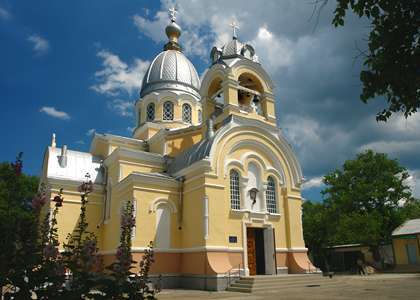

Location: Feodosiya
Church of the Kazan icon of the Mother of God (Церковь Казанской иконы Божией Матери) is an Eastern Orthodox Church in a resort town of Feodosiya. Current temple was built in the early 20th century, but its history starts in 1887 when Count Nicholas Heiden gave away his private residence or dacha Kafa in Feodosiya to Toplovsky Monastery of Saint Paraskevi. In 1891 a wooden church was constructed and dedicated to Saint Panteleimon the Healer. In 1907 a new bigger stone Cathedral of the Kazan Icon of the Mother of God was built. It became one of the most beautiful and largest buildings in Feodosiya. Architect of the cathedral G.L. Cale designed his cathedral in the Russian- Byzantine style. it was completed and consecrated in 1911.
Construction of the cathedral
The headman of the St. Petersburg
Kazan Cathedral, Count Nikolai Geiden, in 1887 transferred his dacha
"Kafa" in Feodosia to the jurisdiction of the Toplovsky Holy Trinity
Paraskevievsky Monastery, and later it received the name of the Kazan
Compound of the Toplovsky Monastery. On February 24, 1890, the Holy
Synod of the Russian Orthodox Church approved this gift of Heyden for
the Toplovsky Monastery "for the construction of a church in the name of
the Kazan Icon of the Mother of God and an elementary school for girls."
In 1892, the inhabitants of the city allocated a plot of land near
the dacha, where they were to build a temple in memory of the miraculous
rescue of the royal family during the train crash on October 17, 1888.
However, the Theodosians did not have money for the construction of the
temple. Baroness Maria Frederiks and the organizer of one of the first
in Russia Communities of Sisters of Mercy Marfa Sabinina presented the
city with a portable church, which had previously been located in the
southern coast estate of Kastropol. The church was consecrated by Bishop
Martinian in honor of the great martyr and healer Panteleimon.
On
July 26, 1890, a religious procession with the icon of the Kazan Mother
of God was held from the Toplovskaya monastery to Feodosia, which later
became an annual tradition. The tradition of religious processions
ceased in Soviet times.
In 1907, the wooden church of the
Toplovsky monastery was dismantled, and instead of it, the construction
of a stone cathedral in the name of the Kazan Icon of the Mother of God
began. The construction was carried out according to the project of the
Theodosian architect Heinrich Keil in the traditions of the
Russian-Byzantine style. The cathedral was consecrated in 1911 with the
participation of Bishop Feofan of Tauride and Simferopol.
Cathedral during the years of Soviet power
After the outbreak of the
Civil War, in 1919, the entire Toplovsky monastery, its courtyard,
churches and other buildings were looted, and many of its shrines were
lost.
At the beginning of the Great Patriotic War, the 12th army
collection point for Soviet prisoners of war was located in the
courtyard. Until 1943, the monastery was in disrepair, and during the
German occupation, it was opened for the purpose of holding services for
the troops of the Romanian unit. After the entry of Soviet troops into
Feodosia in April 1944, a permanent church service was resumed in the
church.
During the 1950-1960s. On the initiative of the
Simferopol Archbishop and the Crimean Saint Luke, the cathedral was
renovated with artistic paintings and filled with church utensils.
Solemn liturgies were also held. During this period, archpriests John
Kalishevich and Grigory Beztalanny served in the church. From 1967 to
2009, Father Anatoly Chepel was the rector of the cathedral.
Current state
In 2004, on the initiative of Abbess Paraskeva, abbess
of the Toplovsky Monastery, and with the blessing of Metropolitan
Lazarus of Simferopol and Crimea, the tradition of religious processions
with the icon of the Kazan Mother of God from the Toplovsky Monastery to
Feodosia was restored.
Since 2009, the rector of the cathedral
has been Archpriest Vasily Bai.
In 2011, in honor of the
centenary of the cathedral, a reconstruction was carried out in it, the
foundation of the fence was strengthened, paving of the inner territory
with tiles and the construction of a ramp for the disabled were planned.
In connection with the formation of an independent Feodosia-Kerch
diocese, the Kazan Cathedral becomes the cathedral church of the new
diocese.
The lightness and elegance of the architectural appearance of the cathedral, created by the semicircular tops of the walls, thin columns in the corners of the building, is noted. The dome of the building is made in the Byzantine style and resembles the helmet of a Russian warrior. The light drum contains ten arched windows. The interior of the cathedral is regarded as quite rich, in particular, its artistic painting, which presents gospel scenes with images of Jesus Christ and the Virgin Mary, the Holy Great Martyrs Catherine and Barbara, as well as the Holy Great Martyr Panteleimon. The altar is framed by a rich iconostasis, on the sides of which are the Holy images of the Kazan Icon of the Mother of God, the Most Holy Three-Handed, the Most Holy Intercessor of the Travelers, the Tikhvin Icon of the Mother of God.